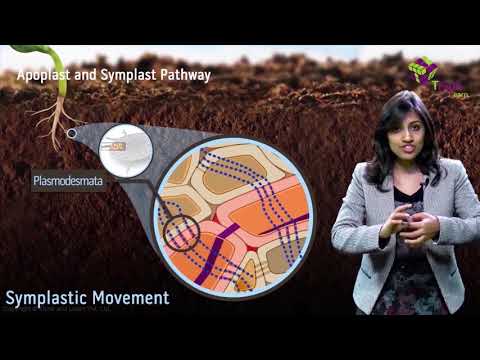The absorption of water by the roots of the plants takes place in two ways:
- Active absorption
- Passive absorption
In the active absorption, the water first enters the cell sap and passes from one cell to another. This type of movement where protoplasm is involved is called symplast.
In passive absorption, water moves through the apoplast of the root. The apoplast path includes the cell wall and intercellular spaces.
Apoplast and Symplast
Apoplast and symplast are two separate pathways in plants that initiate the passage of water along with ions from root hair via root cortex to xylem elements. These routes may exist either simultaneously or separately having different rates.
Let us have a detailed look at apoplast and symplast and the difference between the two.
Also Read: Transportation in Plants

What is Apoplast?
The apoplast is the space outside the plasma membrane consisting of intercellular spaces where the material diffuses freely. It does not involve protoplasm in the plant tissues but involves the non-living parts of the plant such as cell wall and intercellular spaces.
Apoplast Pathway
In the apoplast pathway, water is transported from root hair to xylem through the cell wall of intervening cells. Apoplastic water movement beyond the cortex is blocked by the Casparian strip of endodermal cells. Hence, the symplastic route is utilised to deliver water and ions beyond the cortex. Since the apoplast is made up of non-living components, the apoplastic route is least affected by the metabolic state of the root.
What is Symplast?
Symplast consists of a cytoplasmic network of every plant cell interconnected by plasmodesmata. Symplast does not involve intercellular spaces and cell walls and is therefore considered as the complete living component of the plant tissue.
Symplast Pathway
The pathways of ion and water created by symplast are known as the symplastic pathway. This pathway offers resistance to the flow of water since the selective plasma membrane of the root cells handles the intake of ions and water. Moreover, the symplastic pathway is affected by the metabolic states of the root. The symplastic route occurs beyond the endodermis in plants. The endodermis contains a suberised band called the Casparian strip. The Casparian strip is impervious to water, therefore water is directed through the non-suberised wall regions and crosses the cell membrane to reach the xylem. Hence, water and other solutes enter the vascular bundle through the symplastic pathway by crossing the endodermis, since the apoplastic water movement beyond the cortex is blocked by the Casparian strip.
Difference between Apoplast and Symplast
The major difference between apoplast and symplast is as follows:
| Criteria | Apoplast | Symplast |
| Parts | Consist of intercellular spaces and cell walls. | Consist of protoplasm. |
| Living and Nonliving parts | Consists of non-living parts. | Consists of living parts. |
| The rate of Pathways | The apoplastic pathway is fast. | The symplastic pathway is slower than the apoplastic pathway. |
| Metabolic State | No effect on water movement. | Metabolic states interfere with the flow of water in the symplastic pathway. |
| Transportation | More ions and water are transported through the apoplastic pathway in the cortex. | Water and ions are mainly delivered through the symplastic pathway beyond the cortex. |

Frequently Asked Questions
What do you mean by the apoplast pathway?
In the apoplast pathway, the water moves through the adjacent wall of the epidermis and cortex without entering the cytoplasm.
What is an apoplast?
The apoplast is the system of adjacent, continuous cell walls. It refers to the space outside the plasma membrane within which the molecules can freely diffuse.
Is apoplast active or passive absorption?
The apoplast is the passive absorption that takes place through the apoplast of the root that comprises the cell wall and intercellular spaces.
What is the importance of the Casparian strip?
The Casparian strip is a band of waterproof tissue found on the sidewalls of the endodermis of roots. The apoplastic water movement beyond the cortex is blocked by the Casparian strip. It prevents water from entering the pericycle that is important in inducing root pressure.

Very useful. thank you
Very useful
It’s nice and useful
Thank you
When we say (sap), does that mean apoplast or symplast !!
Thank you so much
Wow what a good explanation no works to say
Thank you Byju’s🙂